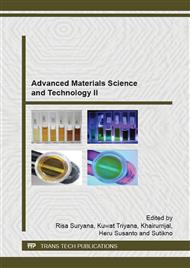p.65
p.69
p.73
p.78
p.84
p.88
p.92
p.96
p.100
The Effect of Low Vacuum Curing to Physical and Magnetic Properties of Bonded Magnet Pr-Fe-B
Abstract:
In this paper, the physical and magnetic properties of isotropic bonded magnet Pr-Fe-B manufactured at atmospheric and low vacuum condition were discussed. The commercials Pr-Fe-B melt spun ribbon which mixed with epoxy resin binder was used as starting materials. The compaction method was using hydraulic press of 3 grams sample (ϕ9 mm) with force of 3 tons. The atmospheric and low vacuum (P ~ 10 mbar) environment during curing process were sets with temperature varied from 100 °C to 200 °C. The curing time (t) variations of 30 minutes to 4 hours were also done in the selected temperature to understand the short term aging effect. The optimum curing time was generated in 4 hours which produced at the low vacuum curing that increased the sample density and magnetic flux with the value of 5.846 g/cm3 and 2.51 kG, respectively. Generally it can be concluded that the process of low vacuum curing give a positive trends for manufacturing the bonded magnet Pr-Fe-B. The analysis of microstructure for mentioned parameters using SEM were also discussed.
Info:
Periodical:
Pages:
84-87
Citation:
Online since:
August 2015
Price:
Сopyright:
© 2015 Trans Tech Publications Ltd. All Rights Reserved
Share:
Citation:


